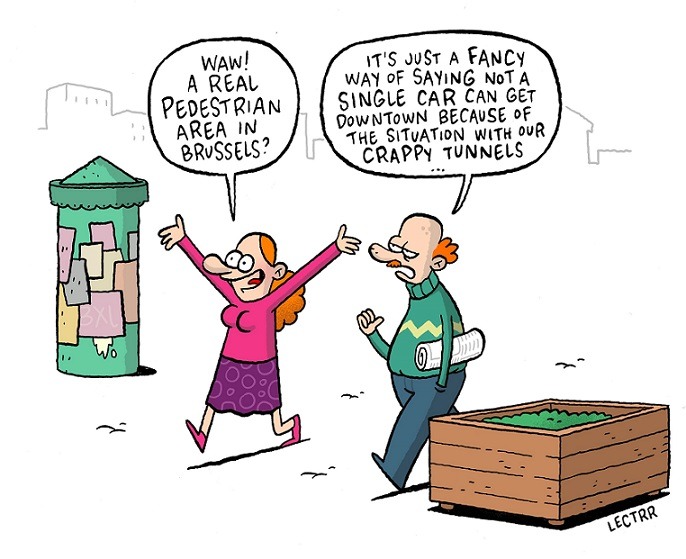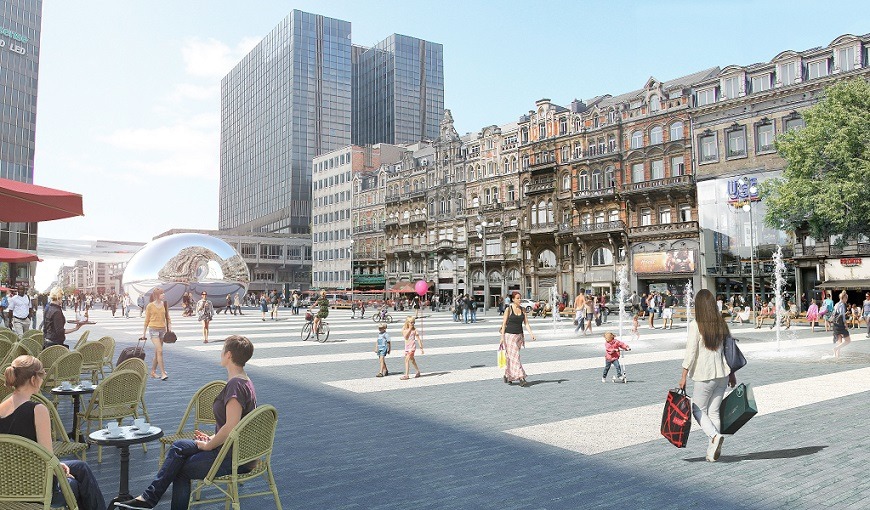Last year saw the Brussels authorities trial of a car-free pedestrian area in the centre of Brussels along the Boulevard Anspach. The experiment ran from June 2015 until February 2016. The area included facilities such as various forms of wooden benches, petanque sandpits and table tennis tables, which helped create a convivial atmosphere with pedestrians and cyclists mingling.
Now it looks like the pedestrian area is here to stay as the Brussels authorities are planning works in the area from around the end of May/early June. A permit has been granted but no decision has been taken yet on which entrepreneur will do the work.
The overall cost, to be paid by the Belgian federal government, will be around 10 million euro, which includes work on the Bourse and De Brouckère subways (including repairing water leaks) and new bike parking facilities close to the subways. The biggest part of the pedestrian area is due to be in place by 2018 with further work being done to renovate the Bourse building and the area around the Bourse in 2019.
The Deputy Mayor of Brussels, Els Ampe, who is the ‘Echevine de la Mobilite’ [Deputy Mayor for Mobility], is a big player in the project. Her spokesperson Marc Daniels does not expect any of the work to be completed this year but he explained that the works as a whole are due to be completed by the end of 2018. The work will be done in phases starting from the outer extremities of Boulevard Anspach (i.e. Place de Brouckère and Fontenas) and working their way towards the centre. So this year, work will start on De Brouckère square and Fontenas square.
Better than Las Ramblas?
Clearly excited about the project, Mr Daniels said that “it will be better than Las Ramblas, the main boulevard in Barcelona”. He said it was the first major change to the centre of Brussels in a hundred years. “This will be a big change for the heart of Brussels. It will mean an evolution in mobility in Brussels. We will have more mobility with bicycles and use of the metro and less cars in the heart of the city. As a result, we will get a new way of life, we will bring pollution down and we will have a city where everyone likes to be,” he said. For now, there are no further pedestrian plans, he added.

In the future, the plan is for this big pedestrian area to feature new green spaces, fountains and art works. Ms. Ampe said that there would be a water feature in front of the Marriott Hotel, trees planted in the ground and lots of new and permanent furniture. For this summer, the Mayor of Brussels is still considering what to do. “We won’t repeat the petanque piste because lots of dogs fouled it. But we’ll be looking to improve the temporary furniture,” said Ms Ampe.
Cyclists’ wishlist
The GRACQ, a big cycling association involved in discussions every two or three months with the deputy mayor and the Brussels authorities, is happy that the pedestrian zone is going ahead but not happy with the process. Florine Cuignet, who is responsible for communication and Brussels policy at the GRACQ cycle federation, says that the GRACQ submitted a list of proposals but that it does not feel that it is being properly heard or given full information.
She said that “it is difficult to find places to cycle safely and out of the pollution” and does not think that the Brussels authorities have “sought to reduce the number of cars in the centre of Brussels”. In her view, the effect of the pedestrian area has been to “shift cars to small roads”. She also fears that cyclists will end up “without secure cycle lanes and very narrow cycle lanes”. But she added that the GRACQ is “ready to work constructively and would like to discuss its list of proposals seriously”.
Confronted with some of these points, Ms Ampe said that she agreed with some things but not everything on the list. One idea that she said had been put forward and that she is against, is having a cycle lane in the pedestrian area “because it could be dangerous for pedestrians”. Her view is that cyclists can either choose to cycle slower in that area or go faster in cycle lanes outside the area. In that context, she says an extra 3,000 metres of cycle lanes have been painted in the surrounding area. The list calls for separated cycle lanes and she says these are indeed planned in many places for 2017. They will be separated by putting them at a different level from the pavement and from the road and making the lanes of a different material.
Complaints of an “anti-car policy”
Stefani Lorenzo, spokesperson for the French part of Belgium for the Touring car organization, feels that the Mayor and the Brussels Region have an “anti-car policy”. In his view, things are being done the wrong way around. “The first thing that should be done are the alternatives for people (e.g. better public transport and more parking spaces) and then the pedestrian area,” he says. He also argued that the pedestrian area is “killing the shops and the economy”.
When The Brussels Times put these points to Els Ampe, she said that it “would have been better doing things the other way round but that it was not possible” because that would have meant holding the pedestrian zone back until 2018, “three months before the elections when everyone is in election mode”.
As for the economy, she conceded that when the pedestrian area was first in place last year, there was a negative effect on businesses in that area (with sales down 20 to 30%) but that sales had been better in October than the year before (before they subsided again following the Paris terrorist attacks).
As for parking, she said that four car parks in the city centre were planned, of which one was due to be ready in June 2018, and another big car park near Heysel for around 10,000 cars was due to be ready in 2019. From there, the idea is that people can take the subway to the centre.
As for the impact of the works when finished, she believes that the results will be “beautiful” and that it will have a positive impact on shops and on the happiness of people living in the area.
By Julian Hale

